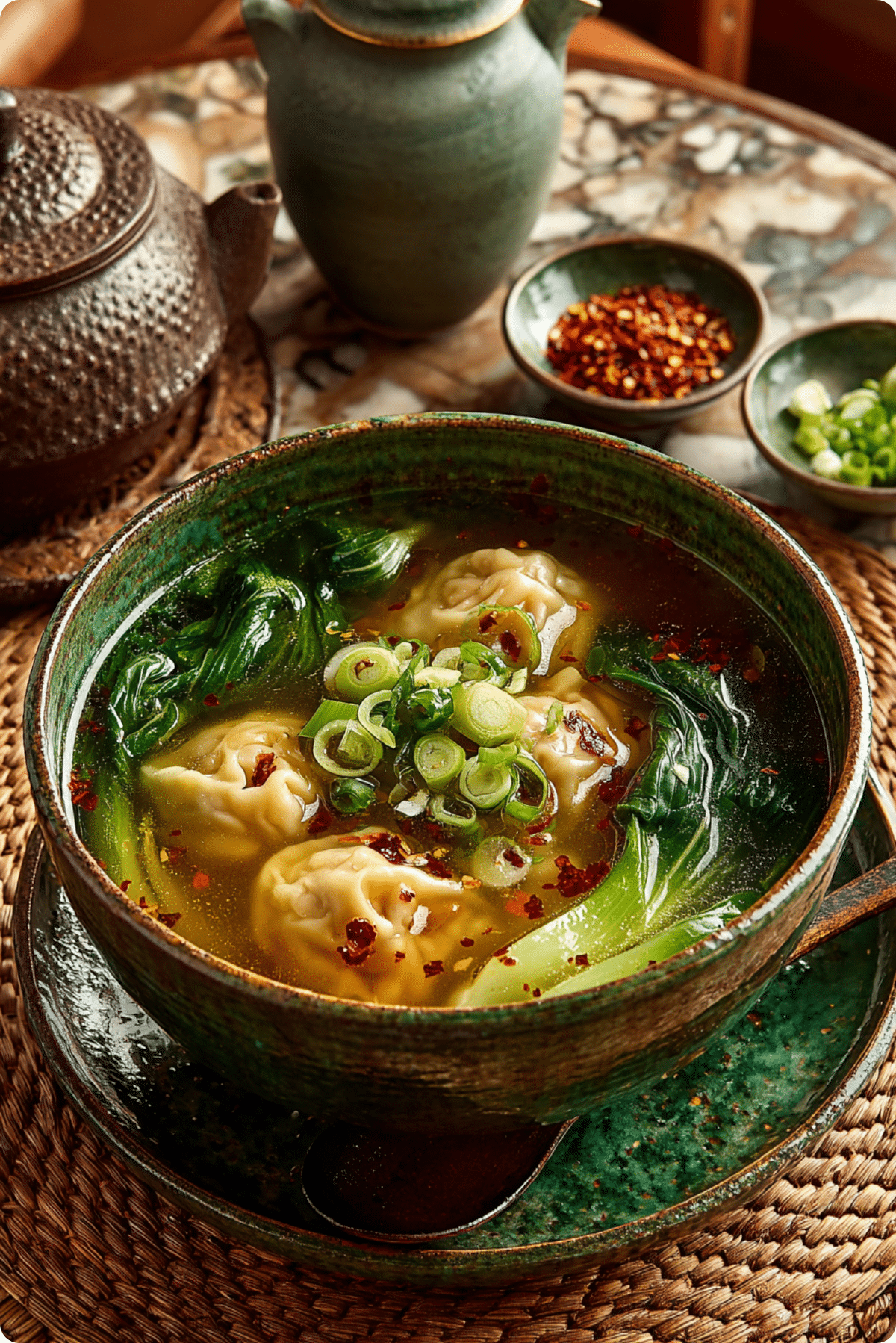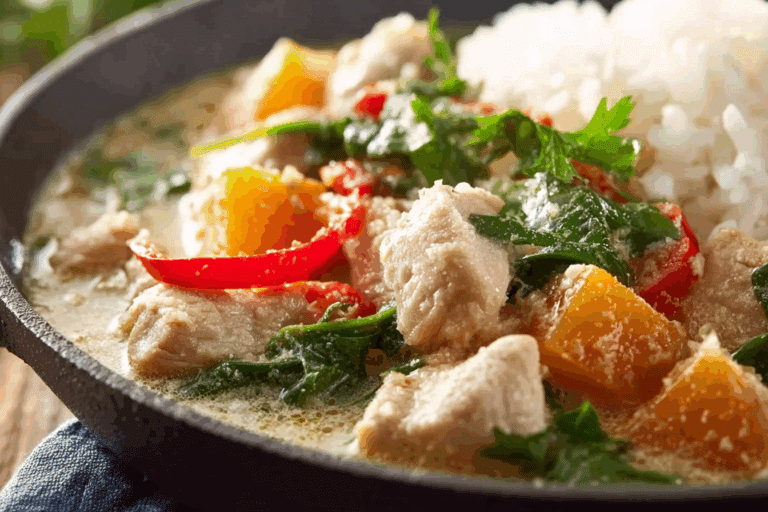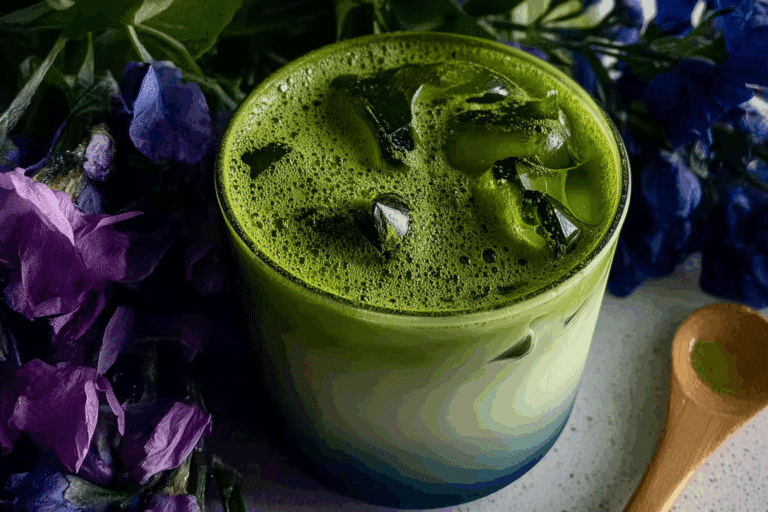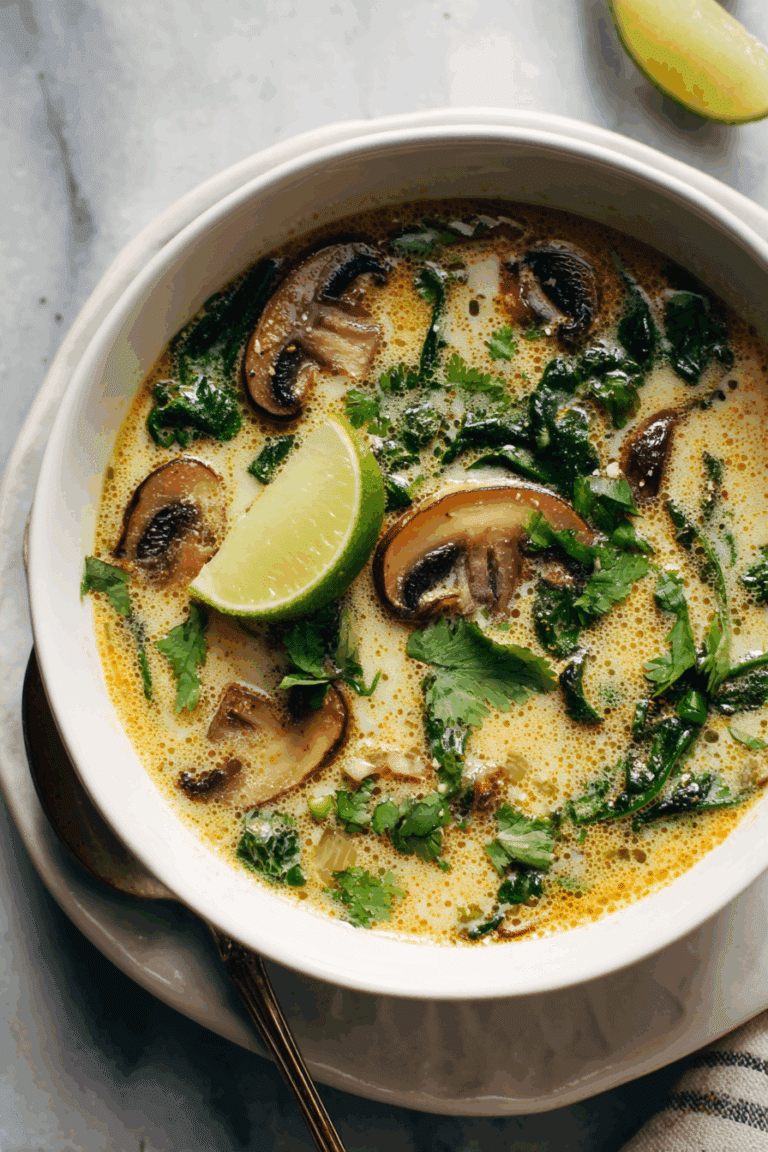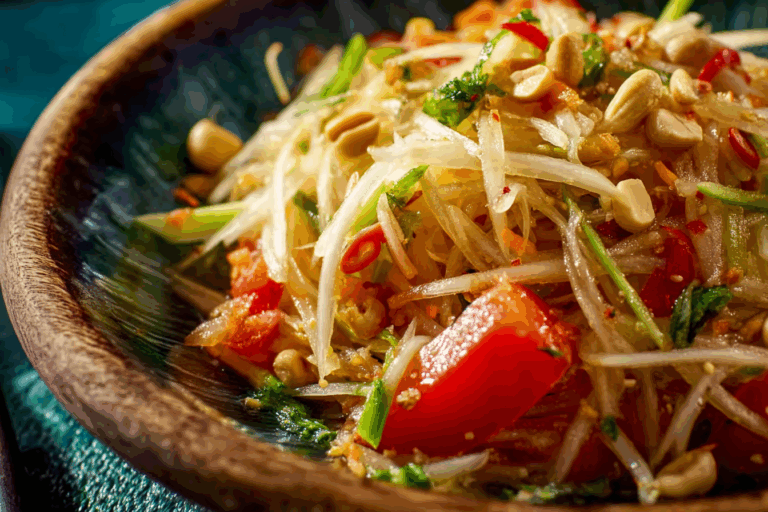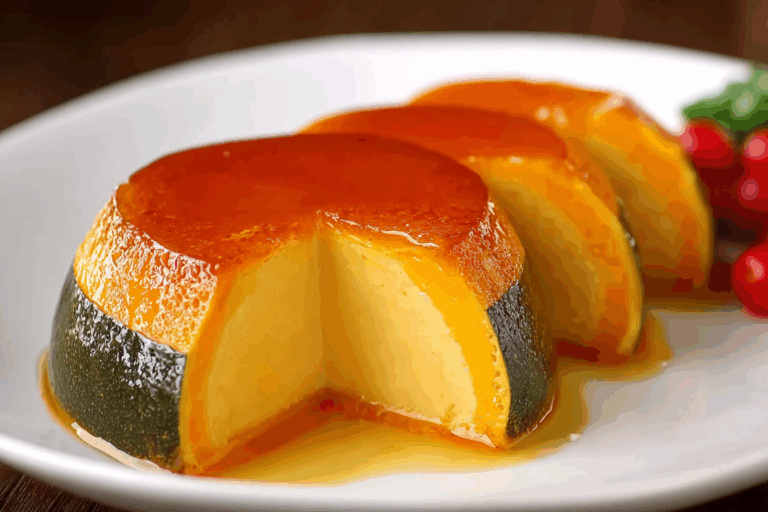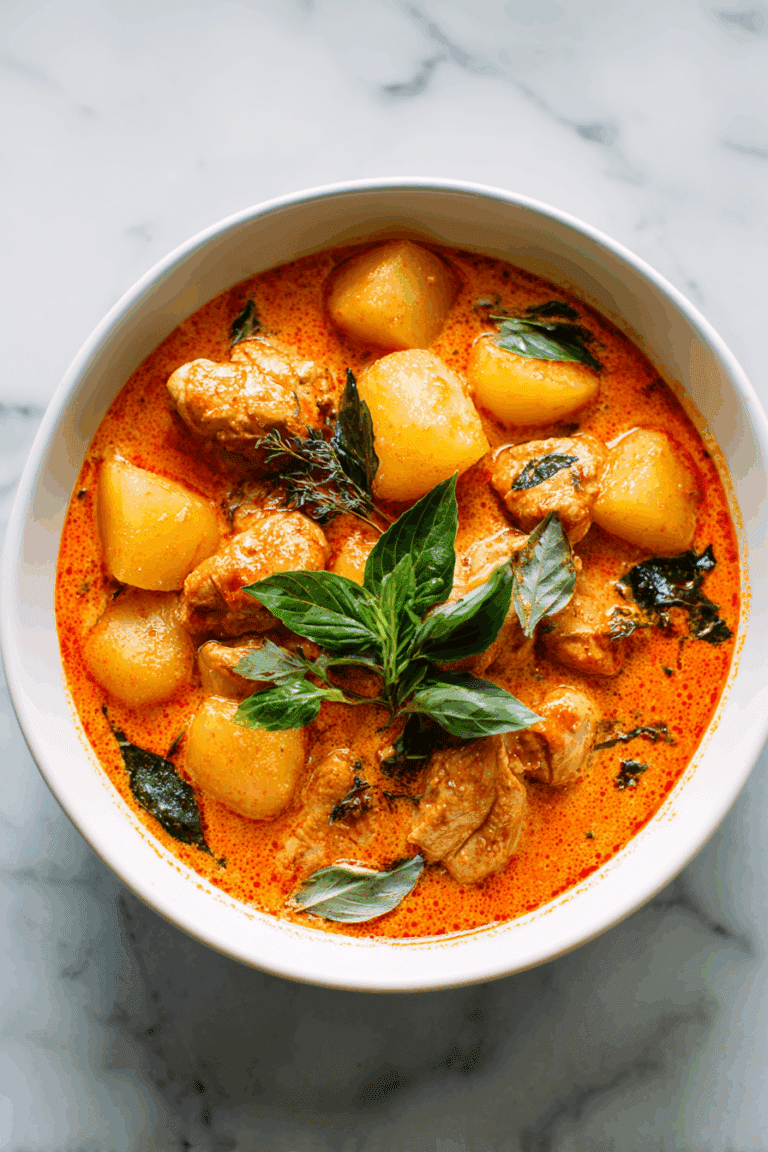Irresistible Thai Wonton Soup Recipe You’ll Love
Thai Wonton Soup Recipe is one of those dishes that instantly warms both your body and soul. From the very first spoonful, it brings you the delicate flavors of Thailand in a way that feels cozy, familiar, and just a little bit magical. I still remember the first time I tried this soup while visiting my aunt’s small kitchen in Bangkok, where the aroma of soy sauce, white pepper, and garlic filled the air. It’s a memory that has stayed with me for years, inspiring my love for Thai food and the simple joy of cooking at home.
If you’ve ever read the About Page on Just Thai Recipes, you know this journey began out of pure love for Thai comfort food and a deep desire to share those authentic home-cooked flavors with everyone. My goal was always to make traditional Thai recipes easy and approachable for anyone who wants to bring those delicious Southeast Asian tastes into their own kitchen. This Thai Wonton Soup Recipe reflects exactly that mission, combining simplicity, flavor, and heart in every bowl.
In this article, you’ll discover everything you need to know about how to make a traditional Thai wonton soup recipe, including the ingredients, step-by-step cooking process, tips for achieving that perfect broth, and even creative variations like Thai red curry wonton soup. We’ll talk about the origins of the dish, how to serve it beautifully, and why it has become one of the best Thai wonton soup recipes loved by so many home cooks around the world.
This is more than just a recipe it’s a story of warmth, culture, and connection. So grab your ingredients and let’s start making your very own Thai Wonton Soup Recipe that will easily become one of your new favorite comfort foods.
Table of Contents
Table of Contents
Ingredients
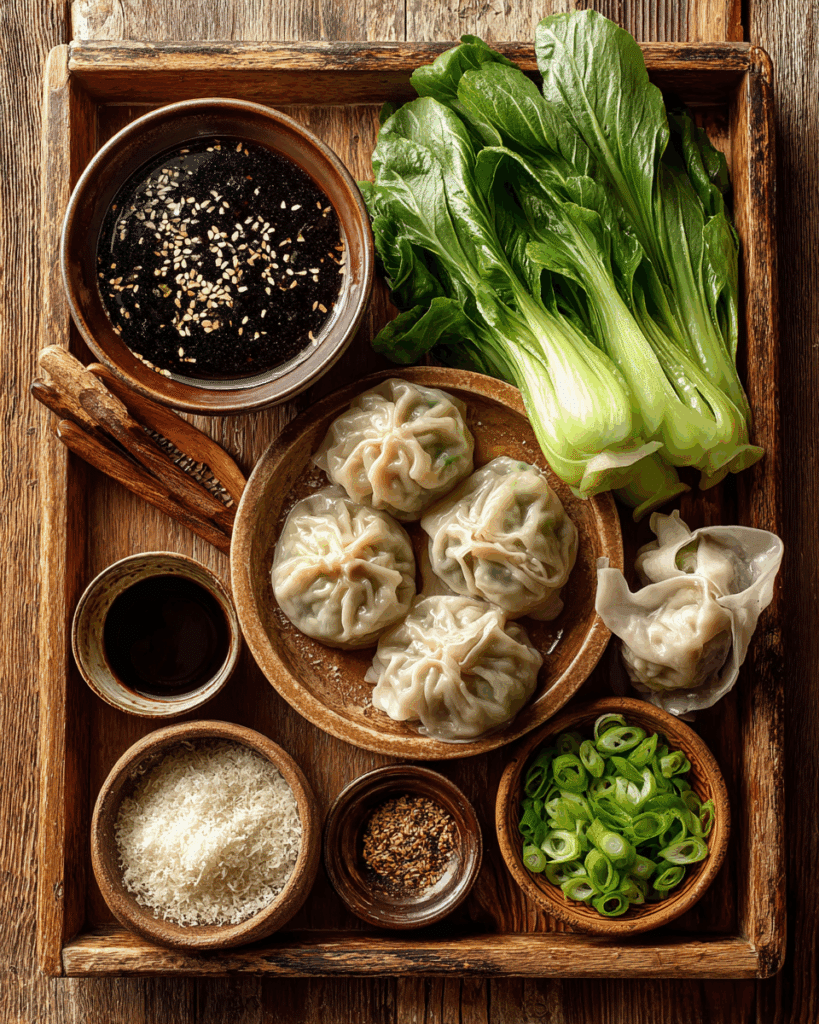
To make an authentic and Thai Wonton Soup Recipe, you’ll need only a few simple ingredients, most of which you probably already have in your pantry. The secret lies not in how many ingredients you use, but in how you combine them to create layers of flavor that define Thai cuisine. Each element brings balance salty, savory, slightly peppery, and soothingly light.
Essential Ingredients
▢ 3 cups of water
▢ ½ tablespoon light soy sauce
▢ 1 bouillon cube (preferably chicken or vegetable)
▢ ¼ teaspoon white pepper powder
▢ 12 wontons (store-bought or homemade, see notes below)
▢ 4 bok choy, washed and chopped
▢ Green onions, for garnish
The Thai Wonton Soup Recipe uses a light broth that’s both aromatic and satisfying. The soy sauce adds umami depth, while the bouillon cube boosts that rich savory base without the need for long simmering times. The white pepper provides a gentle kick typical of Thai soups, balancing the mild sweetness of the bok choy and the delicate flavor of the wontons.
Notes and Ingredient Tips
Wontons: You can use ready-made wontons for convenience, but if you’re up for it, try making your own. Homemade wontons often have a better texture, and you can fill them with ground chicken, shrimp, or even a mix of pork and mushrooms. If you’re looking for ideas, check out some of our other dishes that use wontons on [Internal Link: Thai Chicken Wontons Recipe] or [Internal Link: Homemade Thai Dumpling Soup].
Bok Choy: Bok choy gives a beautiful green color and a gentle crunch to the soup. If you can’t find it, you can substitute it with baby spinach, napa cabbage, or Chinese broccoli. The key is to add the greens at the end so they stay tender and bright.
Bouillon Cube: If you prefer a stronger broth, replace the bouillon cube with a homemade chicken stock. You can find a guide for making flavorful Thai-style stock on [Internal Link: Authentic Thai Chicken Stock Recipe].
Seasoning: Adjust the saltiness based on your taste. Some people like to add a few drops of fish sauce for that extra Thai flair, but it’s completely optional if you prefer a milder flavor.
This list might seem simple, but every ingredient plays an important role in building the rich flavor base of this authentic Thai wonton soup recipe. Once everything is prepped and ready, it’s time to move on to the most exciting part cooking.
Step-by-Step Instructions
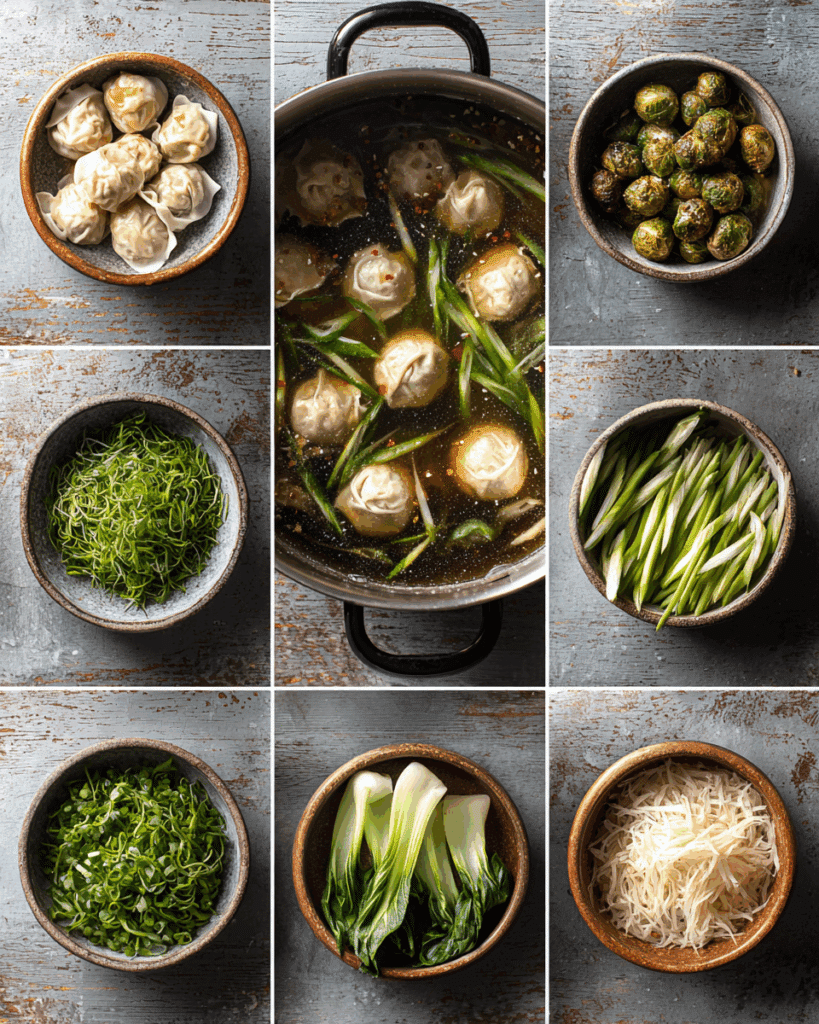
Making your own Thai Wonton Soup Recipe is easier than you might think. You don’t need hours in the kitchen, and you don’t need fancy ingredients. What you do need is patience, attention to flavor, and a love for simple Thai cooking. Follow these steps carefully to create the perfect bowl of soup.
Step 1: Make the Broth
In a medium pot, bring three cups of water to a gentle boil over medium-high heat. Once it starts to bubble, add the bouillon cube, light soy sauce, and white pepper powder. Stir well until everything dissolves completely. The moment that fragrant aroma hits your nose, you’ll know you’re on the right track. Lower the heat to medium and let it simmer for about five minutes, allowing the flavors to come together. This broth is the heart of your Thai Wonton Soup Recipe, so don’t rush this part.
If you want to explore more about building traditional Thai broths and soup bases, you can visit these helpful guides: Wonton Soup เกี้ยวนำ้ or Thai Wonton Soup
Both resources give amazing insight into how to create that layered Thai flavor using simple ingredients.
Step 2: Cook the Wontons
Once your broth is ready, gently drop the wontons into the simmering liquid. Stir carefully to prevent them from sticking together. You’ll notice the wontons starting to rise to the surface after four to five minutes—that’s when you know they’re perfectly cooked. Each wonton should look slightly translucent, with the filling tender and juicy inside.
If you’re making homemade wontons for your Thai Wonton Soup Recipe, make sure to seal the edges well so they don’t open up in the broth. You can fill them with chicken, shrimp, or even tofu for a vegetarian twist.
Step 3: Add the Bok Choy
Add the chopped bok choy to the pot and cook for just one or two minutes. It should become bright green and slightly tender, but not mushy. Overcooking will make the greens lose their texture and color, which is why timing is key here.
The bok choy also adds a subtle sweetness that balances out the saltiness of the broth. This step transforms your simple soup into something truly special, giving it that fresh Thai balance of flavors.
Step 4: Serve and Garnish
Finally, ladle the soup into bowls. Make sure each serving has a good mix of wontons, broth, and bok choy. Garnish with freshly sliced green onions for a pop of freshness, and if you like a bit of spice, sprinkle some chili flakes or extra white pepper on top. The result is a beautifully fragrant, light, yet deeply satisfying soup.
You can serve this Thai Wonton Soup Recipe on its own for a light meal or pair it with jasmine rice or a side of Thai spring rolls for a more complete dinner.
The best part about this soup is its flexibility. Once you’ve mastered this basic version, you can experiment with different fillings or seasonings to make it your own. Try adding shrimp wontons, a spoonful of red curry paste, or even a splash of coconut milk to turn it into a Thai red curry wonton soup variation that bursts with creamy flavor.
Tips and Tricks
When you are making your Thai Wonton Soup Recipe at home, a few small choices can completely change the flavor and texture of the final bowl. This part is all about the little things that Thai home cooks do quietly, which is why their soup always tastes like the best Thai wonton soup recipe you have ever had, even though you watched them make it in just one pot. I want to walk you through those details so your version feels balanced, soothing, and deeply satisfying.
Build flavor early, not late
One of the most important tips for a successful Thai Wonton Soup Recipe is to season your broth from the beginning. When you start with water, soy sauce, a bouillon cube, and white pepper, you are already creating the foundation of what people recognize as an authentic Thai wonton soup recipe. Do not wait until the end to adjust because the wontons also bring salt into the pot. If you add a lot of salt or fish sauce at the end, the soup can taste sharp instead of round.
So here is what I recommend. Taste the broth before you add the wontons. If it tastes a little under seasoned at that moment, that is perfect. Once the wontons simmer and release some of their filling juices, and once the bok choy cooks down, the broth will taste deeper and more savory. This step is small, but it is something you see in almost every traditional Thai wonton soup recipe.
Use light soy sauce instead of dark soy sauce
Light soy sauce gives you salt and umami without making the broth heavy or too dark. Dark soy sauce is stronger and slightly sweet, which might work in stir fries, but it can overpower the delicate nature of a clear soup. A Thai Wonton Soup Recipe is meant to feel clean and almost medicinal in a good way, like something you would crave when you are tired or not feeling well. That is why clarity and brightness matter. If your soup turns too brown, it starts to taste more like a braise and less like a soup.
If you want to make the best Thai wonton soup recipe for someone who prefers low sodium, you can try low sodium soy sauce and then add a couple of drops of fish sauce right at the end. This gives you depth without going overboard with salt. Keep in mind that fish sauce is powerful, so add a little at a time and taste.
Do not overcook the wontons
The wontons are the star of any Thai wonton recipe, and they are delicate. If you let them boil too long, the wrappers will start to fall apart and the filling will leak into the broth. You do not want that. Instead, you want each wonton to stay whole and tender, almost silky.
To keep them just right, make sure the soup is simmering gently, not at a hard rolling boil. A Thai Wonton Soup Recipe should not look aggressive in the pot. It should look calm. When the wontons float, give them another minute to cook through, then move on to the next step. If you are using frozen wontons, you may need an extra minute or two, but still keep the heat steady.
Another simple tip is to stir slowly at the bottom of the pot when you first add the wontons. This prevents sticking and tearing. Use a spoon to nudge them apart, not tongs, which can rip the wrapper.
Add greens at the end for color and texture
Bok choy cooks fast, and that is good news because you do not want soggy vegetables in your Thai Wonton Soup Recipe. Add the bok choy at the very end and simmer for just one to two minutes. You want it to stay bright green with a little crunch in the stems. Texture is an important part of any authentic Thai wonton soup recipe, because you are not just eating for flavor. You are also eating for comfort and for that feeling of freshness.
If you cannot find bok choy, napa cabbage or baby spinach can work. Spinach will wilt faster and taste softer, which some people love when they are in a cozy mood.
Garnish with heat and freshness
Thai food almost always has layers of flavor. Even a simple soup is rarely just salty or just spicy. That is why garnish matters. After ladling your soup, top it with green onions and a pinch of white pepper, which brings gentle heat that lingers in your throat. If you like spice, a sprinkle of chili flakes or a spoon of chili oil on top can turn a standard broth into something very close to a Thai red curry wonton soup feeling, without actually adding curry paste.
These last minute touches are what turn a basic broth into something you would happily call the best Thai wonton soup recipe you have ever made in your own kitchen.
Think about mood and timing
This might sound funny, but how you serve this dish changes how it is enjoyed. A Thai Wonton Soup Recipe is perfect for cold evenings, slow Sundays, after a long trip, or when someone in your home needs a bowl of comfort. It is also an easy lunch if you keep extras in the fridge. And yes, people really do Google things like Thai wonton soup near me when they are sick, tired, or homesick. You can be that comfort source at home instead of ordering out.
Variations
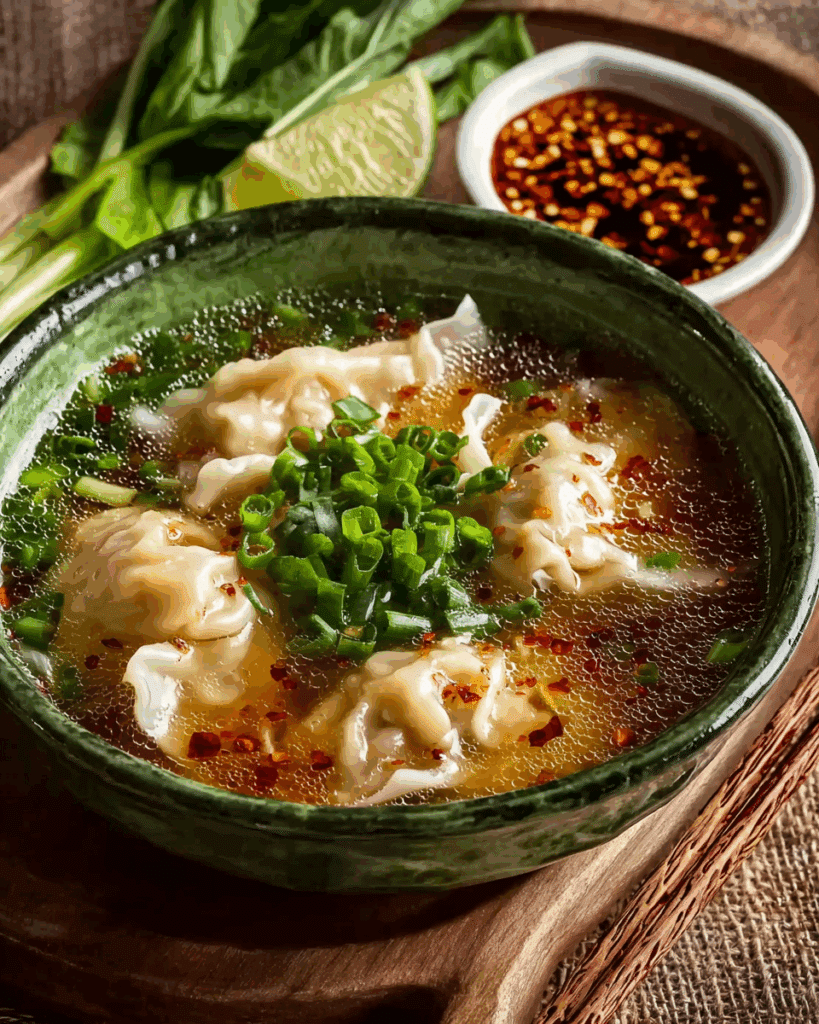
One of my favorite things about a Thai Wonton Soup Recipe is that it is incredibly flexible. You can keep it simple and light, or you can dress it up with bold Thai flavors. You can make it more filling, more spicy, or more nutritious. You can make it vegetarian. You can lean more traditional, or you can go playful and modern. I will walk you through a few delicious versions so you can choose the style that fits your mood. Every variation keeps the soul of the original bowl, which is a balance of warmth, softness, and light aromatics.
Classic and traditional style
If you are going for a traditional Thai wonton soup recipe style, you want a very clean broth, just a little seasoning, and a light touch of white pepper. The wontons in this version are often filled with ground chicken, garlic, and a tiny bit of sesame oil. The broth stays clear. The greens are simple. The goal is purity. You should be able to taste each part on its own. This version feels familiar, almost nostalgic, and it is close to something you would be served at a quiet noodle stand in Thailand early in the morning.
This version is also friendly if you are cooking for kids or anyone who is new to Thai flavor. The broth is not spicy, and the texture is very soft. When someone searches for Thai wonton soup recipe chicken, this is usually what they want, a calm chicken based filling in a light broth.
Spicy Thai red curry wonton soup
If you want something louder and more intense, try a Thai red curry wonton soup style variation. To build this, you start the same exact way as the basic Thai Wonton Soup Recipe, but you whisk a spoon of Thai red curry paste into the broth once the bouillon cube is dissolved. You can also add a splash of coconut milk for creaminess. This turns the soup from clear and light to silky and rich, almost like a small meal in a bowl.
In this variation, shrimp wontons or pork wontons work beautifully because the richness of the curry hugs the filling and makes every bite taste full and rounded. This can easily become the best Thai wonton soup recipe for spice lovers, because it has that satisfying heat that sits on your lips after each spoonful.
To finish it, garnish with fresh cilantro, lime wedges, and a little sliced red chili. That pop of acidity from the lime is important, because it cuts through the richness of the coconut.
High protein chicken version
If you are looking for something filling and you want more protein, try a version of Thai Wonton Soup Recipe that focuses on chicken. This version usually has chicken filled wontons and sometimes even extra shredded chicken stirred into the broth right before serving. It feels more like a full dinner and not just a starter.
This is also the variation people mean when they say Thai wonton soup recipe chicken, because in many Thai households chicken is the default filling for wontons. You can also add thin slices of mushroom, like shiitake or oyster mushroom, to boost umami without adding more sodium. The mushrooms soak up the broth and taste almost meaty.
Vegetable forward, lighter broth
If you want something light and soothing, try a mostly vegetable version. You can use vegetable bouillon, tofu filled wontons, and extra greens. Instead of only bok choy, add napa cabbage, spinach, and sliced carrots, which gives color and natural sweetness. This style of Thai Wonton Soup Recipe is perfect when you want comfort but not heaviness. It is gentle and healing.
People sometimes think that if you skip meat, you lose flavor, but that is not true here. White pepper, soy sauce, and a splash of toasted sesame oil can carry a lot of flavor on their own. The broth will still feel layered and satisfying.
How to make it taste like takeout
We have all had that moment where we search for Thai wonton soup near me because we want that restaurant taste. There are two small additions that move your homemade bowl in that direction. The first is a tiny amount of garlic oil or roasted garlic in the broth. The second is a sprinkle of fried shallots on top right before serving. Those touches bring aroma and depth, and this gives your Thai Wonton Soup Recipe that restaurant comfort that people crave late at night.
You will notice that none of these variations are complicated. You still start with water, soy sauce, bouillon, white pepper, wontons, and bok choy. You just lean the flavor in one direction. Gentle and classic. Creamy and spicy. High protein. Veggie focused. Restaurant style. This flexibility is exactly why so many people love calling this dish the best Thai wonton soup recipe for busy weeknights and cold weather evenings.
Nutrition and Health Benefits
Now let us talk about nutrition, because a Thai Wonton Soup Recipe is not only cozy and delicious, it can also fit into many lifestyles. In this part we will look at calories, protein, greens, and how this soup can support you whether you are craving something light, or you need a comforting recovery meal.
Starting from this section, I am going to repeat the phrase Thai Wonton Soup Recipe often, since many readers search for Thai Wonton Soup Recipe for health information like Thai wonton soup calories, and I want to make sure your Thai Wonton Soup Recipe questions are answered in one place in a clear way.
When you prepare a standard bowl of Thai Wonton Soup Recipe at home using light soy sauce, a bouillon cube, bok choy, and about 12 wontons total for the pot, each serving of Thai Wonton Soup Recipe can be relatively moderate in calories compared to heavier noodle soups. Depending on what you fill the wontons with, your Thai Wonton Soup Recipe may fall roughly in the range of 250 to 350 calories per serving, which is a comfortable and satisfying range for a light lunch or a small dinner. If you are tracking Thai wonton soup calories, keep in mind that pork filling will usually be higher in fat, and chicken filling is usually leaner. Shrimp or mixed seafood fillings keep Thai Wonton Soup Recipe lighter, while still giving you protein.
Protein matters, and this is one of the quiet strengths of a Thai Wonton Soup Recipe. Each serving of Thai Wonton Soup Recipe with chicken or shrimp wontons can offer a meaningful amount of protein, which helps you stay full longer and keeps the meal from feeling like just broth and vegetables.
That makes Thai Wonton Soup Recipe a smart option for someone who wants something soothing, maybe after a workout, or on a night when they do not want something heavy or fried. The gentle heat from the white pepper in a Thai Wonton Soup Recipe can also feel comforting if you are dealing with stuffy sinuses or just feeling run down.
Vegetables are also a big benefit in a Thai Wonton Soup Recipe. Bok choy is packed with vitamins A, C, and K, and it also offers minerals like calcium. This means your Thai Wonton Soup Recipe is not just tasty, it also gives you micronutrients that support immunity and bone health.
When you add more greens like napa cabbage or spinach, your Thai Wonton Soup Recipe becomes even more nutrient dense without adding many calories. So if you are someone who tries to eat more vegetables but does not always love salads, a hot bowl of Thai Wonton Soup Recipe can be a more enjoyable way to get those benefits.
Sodium is worth mentioning too. A Thai Wonton Soup Recipe gets most of its salt from soy sauce and bouillon. If you are watching your sodium intake and you still want to enjoy Thai Wonton Soup Recipe, use low sodium soy sauce and only half of a bouillon cube. Then taste and adjust slowly. This way, you can still have your Thai Wonton Soup Recipe on a regular basis without feeling like you went over your daily salt goals. When people call a bowl of soup the best Thai wonton soup recipe for wellness, they usually mean this lighter and cleaner style.
If you choose the Thai red curry wonton soup style with coconut milk, the nutrition profile of your Thai Wonton Soup Recipe changes. Coconut milk adds healthy fats and makes the broth creamier and more filling, so this version of Thai Wonton Soup Recipe becomes a heartier meal. That can be helpful if you want something that feels more like dinner and less like a starter. You will naturally get more calories, but you will also feel satisfied with a smaller portion because the Thai Wonton Soup Recipe will taste rich and full.
Another good point is how kind this dish is to digestion. A Thai Wonton Soup Recipe is warm, soft, and hydrating, which is comforting when you are recovering from long days, travel, stress, or even when you have a cold. It is not greasy, it is not overly spicy unless you choose to make it spicy, and it is easy on the stomach. That is one of the reasons so many families pass along their own version of a Thai Wonton Soup Recipe and even call it their personal authentic Thai wonton soup recipe for sick days.
You can also use Thai Wonton Soup Recipe as part of meal prep. If you keep extra broth and blanched bok choy in the fridge, and you keep uncooked wontons separate, you can build a fresh bowl of Thai Wonton Soup Recipe in just a few minutes. This trick helps you avoid takeout. Instead of ordering Thai wonton soup near me late at night, you go to your stove, heat some broth, drop in a few wontons, and you have a soothing Thai Wonton Soup Recipe ready to eat. This alone can help you cut fast food calories across the week.
To sum it up in a very real way, a Thai Wonton Soup Recipe can be light or rich. A Thai Wonton Soup Recipe can be high protein or vegetable based. A Thai Wonton Soup Recipe can be mild or spicy. A Thai Wonton Soup Recipe can help you hydrate, warm up, and feel nourished without weighing you down.
When you think about the big picture of everyday eating, and you want something that is realistic and not complicated, a Thai Wonton Soup Recipe fits into almost any routine, which is honestly why so many home cooks search for the most authentic Thai Wonton Soup Recipe and keep it on repeat in their kitchen.
Make-Ahead, Storage, and Freezing
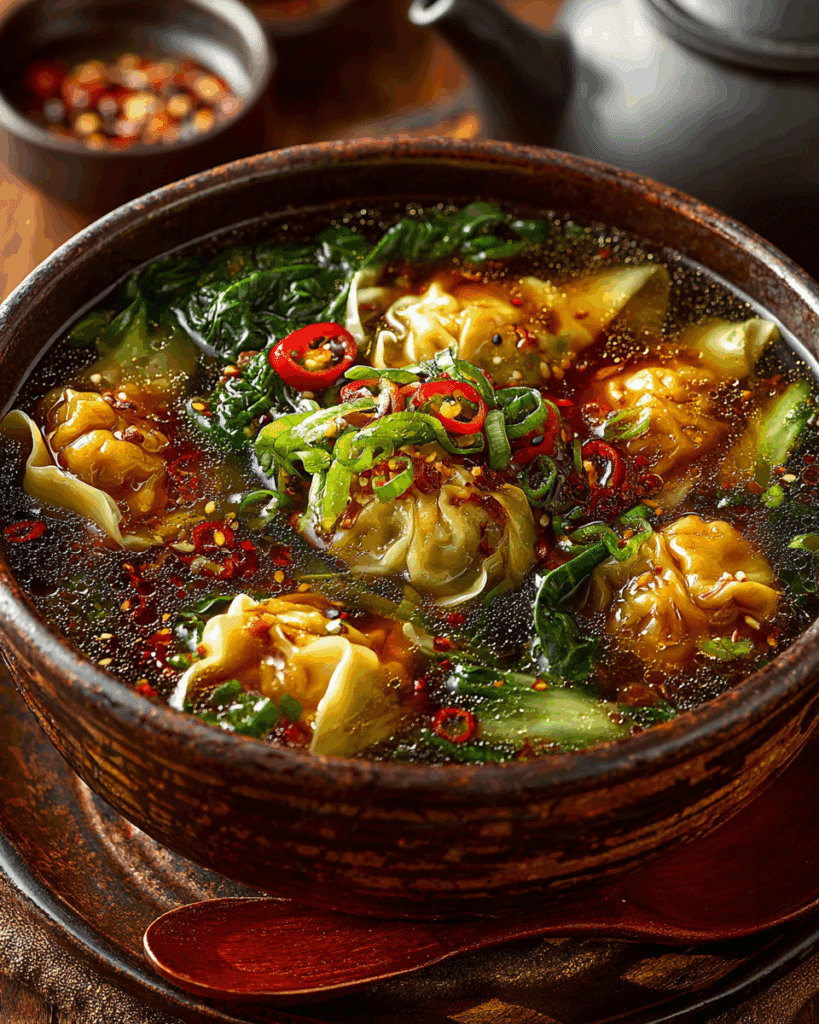
One of the reasons people love making a Thai Wonton Soup Recipe at home is because it is both fresh and practical. It tastes great right off the stove, but it also stores well if you handle it correctly. I have made this soup many times when I know the week ahead is going to be busy, and I always smile when I open the fridge and find a container of homemade Thai Wonton Soup Recipe waiting for me. In this section, I will show you how to make it ahead, how to store it safely, and how to freeze it without losing its flavor or texture.
Make-Ahead Preparation
If you plan to enjoy your Thai Wonton Soup Recipe during the week, it is best to prepare some parts separately. The broth, the wontons, and the vegetables can each be prepped and stored so that when you are ready to eat, you can combine them in minutes. This keeps everything tasting fresh instead of soggy.
Start by making the broth first. Follow the same steps as before with water, soy sauce, white pepper, and a bouillon cube. Let it cool completely, then pour it into an airtight glass jar or container. Keep it in the fridge for up to four days. The flavor will actually get stronger after the first day, which makes your Thai Wonton Soup Recipe taste even better later in the week.
Next, cook your wontons separately in a pot of boiling water. When they are cooked, use a slotted spoon to lift them out gently and place them on a plate lined with parchment paper. Let them cool. If you stack them while hot, they might stick together. Once cool, store them in a single layer in an airtight container. You can lightly brush them with sesame oil to keep the wrappers from drying out. These cooked wontons will last up to three days in the fridge.
The vegetables, like bok choy, should be washed, dried, and stored raw in a plastic or silicone bag with a paper towel inside to absorb moisture. This way, when you reheat your Thai Wonton Soup Recipe, the greens will still cook perfectly fresh and crisp.
When you are ready to eat, reheat the broth on the stove until it starts to simmer. Add the wontons just long enough to warm them through, about one minute. Then toss in the bok choy and cook for another minute or two until tender. You will have a bowl of Thai Wonton Soup Recipe that tastes as fresh as the day you made it.
Storage Tips
If you want to store leftovers of the full soup, it is best to separate the components. The wontons and bok choy can become mushy if they sit in the broth for too long. Store the broth in one container and the wontons and greens in another. This method keeps your Thai Wonton Soup Recipe from losing its texture.
When storing, make sure the containers are sealed tightly to prevent air from getting in. Air exposure can cause the wontons to dry out and the broth to lose its aroma. Refrigerated properly, the broth stays good for four to five days, and the cooked wontons will keep for three days.
If you ever open the container and the broth smells sour or cloudy, it is better to make a new batch. Luckily, this Thai Wonton Soup Recipe is quick and easy to make again, and you can always keep extra wontons in your freezer.
Freezing Instructions
Freezing is a smart way to always have a Thai Wonton Soup Recipe ready to go. You can freeze the broth, the uncooked wontons, or both. The key is to freeze them separately so you can control the cooking process later.
To freeze uncooked wontons, place them on a baking sheet lined with parchment paper. Make sure they are not touching each other. Freeze them until solid, about two hours, then transfer them to a freezer bag. Label the bag with the date and contents. These wontons can last up to two months in the freezer.
The broth can be frozen in ice cube trays or small containers for easy portioning. Once frozen, transfer the cubes into a freezer bag. When you are ready to make the soup, just heat a few cubes of broth on the stove, add frozen wontons directly into the simmering liquid, and finish the dish by adding bok choy or other vegetables at the end. The result will still taste like a fresh Thai Wonton Soup Recipe, not something reheated.
Avoid freezing the vegetables, because leafy greens like bok choy tend to lose texture after thawing. It is better to add fresh greens when reheating the soup.
With these steps, you can always have a warm and comforting bowl of Thai Wonton Soup Recipe available, no matter how busy your schedule gets.
Common Mistakes to Avoid
Making a Thai Wonton Soup Recipe might look simple, but even easy dishes have a few hidden details that can make a big difference. Over the years, I have noticed the same few mistakes come up repeatedly, especially among beginners. The good news is that they are all easy to fix once you know what to watch out for.
Mistake 1: Overboiling the broth
One of the biggest errors people make with a Thai Wonton Soup Recipe is letting the broth boil too hard. When that happens, the broth becomes cloudy and loses its delicate taste. You want a simmer, not a rolling boil. Boiling can also cause the wontons to tear apart when you add them, which ruins the look of the soup.
To fix this, lower the heat once your broth starts bubbling. Let it cook slowly and gently, just enough to release the aroma. A Thai Wonton Soup Recipe should feel soothing, not rushed. Think of the broth as something that should whisper flavor into the dish, not shout it.
Mistake 2: Adding all ingredients at once
Another common mistake is adding everything to the pot at the same time. Each ingredient in your Thai Wonton Soup Recipe has a different cooking time. The broth needs a few minutes to blend flavors. The wontons need about four to five minutes to cook through. The vegetables need just one or two minutes at the end. When you throw everything together, the vegetables get mushy before the wontons are done, and the wontons can overcook by the time the greens are ready.
To fix this, follow the steps in order. Broth first, wontons next, greens last. That rhythm creates the best Thai wonton soup recipe texture and taste.
Mistake 3: Not tasting as you go
A Thai Wonton Soup Recipe depends heavily on balance. The flavor should be savory but light, salty but not too salty, and slightly peppery. If you forget to taste as you cook, it is easy to miss that balance. The soy sauce might be too strong, or the pepper might be too faint.
Fixing this is simple. Taste the broth before adding the wontons. Then taste again before serving. A few drops of fish sauce or a pinch of salt can make all the difference. Do not be afraid to adjust slowly until your Thai Wonton Soup Recipe tastes right to you.
Mistake 4: Ignoring freshness
Bok choy and green onions are delicate. If you use wilted greens or old onions, the soup will taste dull. Fresh vegetables bring brightness and life to the broth, which is what makes Thai food feel so vibrant. Always rinse and dry your greens properly. If the leaves look tired, soak them in cold water for five minutes before cooking. This simple step revives them and makes your Thai Wonton Soup Recipe shine.
Mistake 5: Skipping the final touch
Many people skip the garnish because they think it is optional, but that small sprinkle of white pepper, chili flakes, or green onions is what completes the dish. The garnish wakes up the aroma and gives contrast. A Thai Wonton Soup Recipe without garnish can taste flat even if the broth itself is perfect. Remember that the last few seconds matter just as much as the first few steps.
Avoiding these mistakes will make your Thai Wonton Soup Recipe taste cleaner, more balanced, and more authentic. Cooking is really about patience and awareness, and this soup rewards you for both.
Cultural and Historical Background
Behind every Thai Wonton Soup Recipe, there is a story that connects Thai and Chinese food traditions. This soup might look simple, but it represents a beautiful mix of cultural influences that have shaped Thai cuisine for centuries. Understanding that background makes every bowl feel more meaningful, because you are not just making a recipe, you are continuing a story that traveled across countries and generations.
The wonton itself comes from Chinese cooking, where it has existed for hundreds of years. In Chinese culture, wontons are seen as symbols of wealth and good fortune because their folded shape resembles gold ingots. When Chinese immigrants came to Thailand, they brought wontons with them, and over time, Thai cooks adapted them using local flavors and ingredients. That is how the Thai Wonton Soup Recipe was born, a dish that blends Chinese technique with Thai seasoning.
Thai cooks changed the broth to match local tastes, using soy sauce, white pepper, and sometimes fish sauce instead of heavier seasonings. They also added fresh greens like bok choy, which grow easily in Thailand, and garnished with chili for a bit of heat. The result was a lighter, brighter version of the Chinese original. Today, the authentic Thai wonton soup recipe is considered both comforting and versatile. You can find it in street markets, family kitchens, and even high-end Thai restaurants.
In Thailand, this dish is often served for breakfast or lunch. You might see vendors selling steaming bowls of Thai Wonton Soup Recipe early in the morning alongside noodles, rice porridge, and other simple dishes. It is especially popular during cool or rainy seasons because it warms you up without feeling heavy. Locals often pair it with iced coffee or Thai tea, creating that special contrast of hot and cold that Thai food is known for.
There is also a family tradition behind this recipe. Many Thai households have their own version of Thai Wonton Soup Recipe that gets passed down. Some fill the wontons with shrimp and garlic, while others use chicken or minced pork. The seasonings vary too, but the core remains the same, a light broth, tender wontons, and a touch of pepper. These small variations are what make every family’s Thai Wonton Soup Recipe unique.
If you think about it, this dish reflects what Thai cuisine stands for. Balance, warmth, and adaptability. It is not flashy or complicated, but it connects people. Whether it is a grandmother making it for her grandchildren or a traveler enjoying it for the first time at a street stall, the Thai Wonton Soup Recipe brings comfort in a universal way. It reminds us that food is not just nourishment, it is memory, love, and heritage all in one bowl.
Serving Suggestions
Serving a Thai Wonton Soup Recipe the right way can make the difference between a good meal and a meal that feels like it came straight from a cozy Thai kitchen. Presentation, side dishes, and timing all help bring the experience together. I have served this soup at family dinners, quiet lunches, and even during gatherings where people were trying Thai food for the first time, and every time, it becomes the dish that gets finished first. So, let’s talk about how to serve it in a way that feels warm, thoughtful, and truly complete.
How to serve the Thai Wonton Soup Recipe
When you make a Thai Wonton Soup Recipe, think of it as both a starter and a light main course. If you are serving it as a first course, keep the portion smaller, with about three wontons per bowl, just enough to whet the appetite. If it is the main meal, give five or six wontons per person, plus plenty of broth and bok choy.
Use deep bowls so the broth stays hot longer. Ceramic or stoneware bowls work well because they retain heat better than metal or glass. Before serving, you can even warm the bowls by rinsing them with hot water for a few seconds. This little step keeps your Thai Wonton Soup Recipe hot until the very last spoonful.
When ladling the soup, make sure each bowl has an even amount of wontons, greens, and broth. Garnish with sliced green onions, a pinch of white pepper, and a light drizzle of sesame oil if you like extra aroma. Some people also enjoy adding a few chili flakes for spice. If you want to impress guests, you can top the soup with crispy garlic or fried shallots for that Thai-style restaurant finish.
Pairing the soup with other Thai dishes
A Thai Wonton Soup Recipe pairs beautifully with other dishes because its flavor is mild and clean. You can serve it with jasmine rice, pad thai, or Thai basil chicken. The light broth balances richer dishes and gives your meal rhythm. It is also lovely with Thai spring rolls or papaya salad, since those dishes bring crunch and brightness.
If you are building a full Thai-inspired dinner, start with the Thai Wonton Soup Recipe as your first course, move on to a curry or stir fry, and end with something sweet like mango sticky rice. The soup prepares the palate for bolder flavors, and it helps balance the spices later.
For drinks, a cold Thai iced tea or coconut water fits perfectly. The gentle sweetness from these drinks balances the savory broth, creating that harmony that Thai cuisine is known for.
Seasonal and special occasion serving ideas
This dish fits almost any occasion. During cooler months, the Thai Wonton Soup Recipe becomes a comforting dinner that feels like a hug. In summer, it can still work if you serve it alongside fresh salads or cold noodles. For family gatherings, you can make a big pot and keep it warm on the stove so people can serve themselves throughout the evening.
If you want to turn it into a centerpiece, consider setting up a small “wonton soup bar.” Make the broth, then offer different toppings like chopped herbs, lime wedges, sliced chili, and extra soy sauce so guests can customize their own bowls. This is fun, casual, and interactive, and everyone gets to enjoy their Thai Wonton Soup Recipe their way.
When it comes to serving, the key is warmth and comfort. Whether it is a quiet dinner for one or a lively table of friends, this soup always brings smiles. It’s simple, honest food, and that is what makes it special.
When readers look for a Thai Wonton Soup Recipe online, they often explore related ideas to learn about other Thai soups or variations that match their taste. These related topics are not just keywords, they are what people genuinely search for when they fall in love with this dish. Let’s go over a few of these so you can understand what they mean and how they connect to your Thai Wonton Soup Recipe experience.
Traditional Thai Wonton Soup Recipe
This phrase usually refers to the most classic version made with clear broth, chicken or pork wontons, and fresh bok choy. When someone searches for a traditional Thai wonton soup recipe, they are looking for comfort and authenticity. They want something that tastes like it came from a Thai family kitchen, not a restaurant chain. The steps you have followed so far already capture this tradition perfectly.
Best Thai Wonton Soup Recipe
When people use the word “best,” they usually want something extra special. The best Thai wonton soup recipe has to balance flavor, ease, and appearance. It should taste clean yet rich, be simple to make, and look beautiful when served. The best versions are the ones made with love and patience, like the recipe you now have. It’s not about fancy ingredients, it’s about the care that goes into each step.
Authentic Thai Wonton Soup Recipe
Authenticity in Thai food means honoring balance. You can have soy sauce and white pepper, but you also need freshness from the greens and subtle sweetness from the broth. The authentic Thai wonton soup recipe you’ve made here checks all those boxes. It reflects Thai cooking traditions while still being easy for modern kitchens.
Thai Wonton Soup Near Me
This search is common when people crave comfort food. It’s what people type when they want something soothing on a busy day but don’t feel like cooking. The good news is, now that you know how to make a Thai Wonton Soup Recipe from scratch, you no longer have to search for “Thai wonton soup near me.” You can make your own version at home, fresh and flavorful every time.
Thai Red Curry Wonton Soup
This variation has become very popular because it combines the bold flavors of Thai red curry with the comfort of wonton soup. Adding curry paste and coconut milk transforms your basic Thai Wonton Soup Recipe into something creamy and luxurious. It’s a perfect example of how Thai cuisine evolves, blending traditional and modern tastes into one delicious bowl.
Thai Wonton Soup Recipe Chicken
This is another top search because chicken fillings are light, high in protein, and easy to find. A Thai Wonton Soup Recipe with chicken is perfect for those who want a healthy, balanced meal that still feels satisfying. It’s mild enough for children and can be easily customized with extra vegetables.
Thai Wonton Soup Calories
People often want to know how this comforting dish fits into their diet. The typical Thai Wonton Soup Recipe, as mentioned earlier, is relatively low in calories, especially compared to fried or creamy dishes. It’s a great choice for those who want something warm and filling without feeling heavy.
When you look at all these related searches together, they paint a picture of what people love most about Thai food. It’s comforting, flexible, and nourishing. The Thai Wonton Soup Recipe touches all of these qualities, which is why it continues to be one of the most searched and beloved recipes online.
Conclusion
As we reach the end of this long and heartfelt journey through the Thai Wonton Soup Recipe, I hope you can feel the same warmth and excitement that fills my kitchen every time I make it. This recipe is more than just a set of steps. It’s a connection to culture, comfort, and the kind of cooking that brings people together.
When I first started sharing my Thai Wonton Soup Recipe on Just Thai Recipes, my goal was to make authentic Thai food approachable. I wanted readers to realize that you do not need fancy tools or rare ingredients to create something deeply flavorful. What matters most is patience, love, and curiosity. Those are the ingredients that turn a simple bowl of soup into a memory.
Now you have everything you need to make your own Thai Wonton Soup Recipe at home. You’ve learned the ingredients, the step-by-step process, and the small tricks that Thai cooks use to make their soup taste so balanced. You’ve seen how to adjust it for different variations, from traditional to red curry, and how to make it ahead or store it for later. You even understand the cultural roots that make this dish so special.
If you try this recipe, share it with someone you love. Food always tastes better when it’s shared. Maybe it will become part of your weekly rotation, or maybe it will be that one dish you make on quiet nights when you need comfort. Either way, I hope this Thai Wonton Soup Recipe brings you the same joy it has brought me.
So next time you crave something warm, fragrant, and deeply satisfying, skip the search for “Thai wonton soup near me.” Just head to your kitchen, grab your pot, and make your own. It’s simpler than you think, and it tastes better than any takeout version.
Now go make it, taste it, and let the aroma of your Thai Wonton Soup Recipe fill your home. It’s a little bowl of Thailand, made by you, with love and care.
FAQ
Can I use frozen wontons for my Thai Wonton Soup Recipe?
Yes, you can definitely use frozen wontons, and your Thai Wonton Soup Recipe will still turn out wonderful if you handle them correctly. Frozen wontons are convenient for busy days, and they save time without sacrificing much flavor.
Here’s what to keep in mind. Do not thaw the frozen wontons before cooking. Drop them straight into the simmering broth while it’s gently bubbling. Stir carefully right after adding them to make sure they don’t stick to the bottom of the pot. They’ll need a minute or two longer than fresh wontons, usually about six to seven minutes total.
The key is to keep the broth at a steady simmer, not a rapid boil. A rolling boil can break the wonton wrappers and make the soup cloudy. Once the wontons start to float and look slightly translucent, they’re done.
You can prepare the broth ahead of time, reheat it when ready, and then cook the frozen wontons directly in it.
Finish the Thai Wonton Soup Recipe with bok choy or any greens of your choice. This method is perfect for quick weeknight dinners or when you want something comforting but don’t have the time to start from scratch.
If you love meal prepping, consider freezing your own homemade wontons. It’s a great way to have an almost instant Thai Wonton Soup Recipe whenever you crave it.
How can I make my Thai Wonton Soup Recipe taste more authentic?
If your goal is to make an authentic Thai Wonton Soup Recipe, there are a few simple things you can do that really make a difference. Authenticity in Thai cooking comes down to freshness, balance, and attention to small details.
Start with good quality soy sauce and fresh white pepper. These two ingredients set the tone for your broth. The soy sauce brings salt and depth, while the white pepper adds warmth that lingers without burning. Avoid using black pepper because it changes the flavor completely.
Next, make sure to use fresh vegetables.
In Thailand, cooks rarely use old or pre-cut greens. They wash and chop them right before cooking so they stay crisp and colorful. Bok choy or Chinese broccoli works best in a Thai Wonton Soup Recipe, though spinach or kale can be used if that’s what you have on hand.
If you really want that authentic touch, add a small drizzle of fish sauce before serving. It’s the secret that gives Thai dishes that unmistakable depth. Don’t worry, it won’t make the soup taste fishy. It just rounds out the broth beautifully.
Lastly, remember that Thai food is about comfort and care. Cook slowly, taste as you go, and adjust little by little. That’s what turns a simple recipe into something truly authentic.
Can I make a vegetarian version of the Thai Wonton Soup Recipe?
Absolutely, and it’s surprisingly easy. A Thai Wonton Soup Recipe does not depend on meat for its flavor, which means you can substitute ingredients freely without losing its comforting quality. For the filling, use finely chopped mushrooms, shredded carrots, and tofu. You can also mix in a bit of minced garlic and ginger for added aroma.
Instead of using a chicken or pork bouillon cube, choose a vegetable version. You can also make a homemade broth by simmering onions, carrots, celery, and garlic with a small splash of soy sauce.
It creates a beautiful golden base that complements the wontons perfectly.
When cooking the vegetarian wontons, treat them the same way as regular ones drop them gently into the simmering broth and cook until they float. Add bok choy, napa cabbage, or spinach for that touch of green. The end result will still taste like a true Thai Wonton Soup Recipe, but lighter and entirely plant-based.
If you want extra richness, you can even add a spoonful of coconut milk. It changes the flavor slightly, turning it into a creamy and delicate Thai red curry wonton soup style, but still fully vegetarian. This variation has become one of my favorite comfort bowls on lazy Sundays.
What makes a Thai Wonton Soup Recipe different from a Chinese wonton soup?
That’s a great question, and one that often comes up among people who love both Thai and Chinese cuisine. A Thai Wonton Soup Recipe has a lighter, cleaner flavor compared to most Chinese versions, which tend to be richer or more sesame-based. Thai cooks use ingredients like light soy sauce, white pepper, and sometimes fish sauce, which bring a savory, salty balance without heaviness.
Another difference is the use of greens. In Thailand, bok choy or morning glory is often added for freshness and color, while Chinese wonton soups typically rely more on scallions or napa cabbage.
You can also find optional chili flakes or drops of chili oil in a Thai Wonton Soup Recipe, giving it that gentle heat that Thai cuisine is famous for.
So, even though the base idea is similar delicate wontons in warm broth the Thai version focuses on brightness and balance, while the Chinese one leans toward deeper, darker tones.
If you make this Thai Wonton Soup Recipe once and then try the Chinese version later, you’ll easily taste the difference. The Thai version feels cleaner and a bit livelier on your palate.
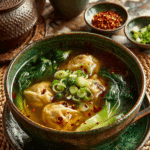
Thai Wonton Soup Recipe
- Prep Time: 10 minutes
- Cook Time: 10 minutes
- Total Time: 20 minutes
- Yield: 2 servings 1x
- Category: Soup
- Method: Simmering
- Cuisine: Thai
- Diet: Low Fat
Description
A comforting and authentic Thai Wonton Soup Recipe made with delicate wontons, fresh bok choy, and a light soy-pepper broth. Perfect for cozy meals, easy to prepare, and full of Thai-inspired flavor.
Ingredients
- 3 cups water
- ½ tbsp light soy sauce
- 1 bouillon cube
- ¼ tsp white pepper powder
- 12 wontons (store-bought or homemade)
- 4 bok choy, chopped
- Green onions, garnish to taste
Instructions
- Make the broth: In a medium pot, bring water to a boil over medium-high heat. Add the bouillon cube, light soy sauce, and white pepper powder. Stir until dissolved, then lower the heat and let it simmer for 5 minutes.
- Cook the wontons: Carefully drop the wontons into the simmering broth. Stir gently to prevent sticking. Cook for 4–5 minutes, or until the wontons float and are fully cooked.
- Add the bok choy: Add the bok choy and cook for 1–2 minutes, just until tender and bright green.
- Serve: Ladle the soup into bowls. Top with sliced green onions and a pinch of chili flakes or extra white pepper if desired.
Notes
- You can use homemade or store-bought wontons depending on your time and preference.
- For a vegetarian version, use vegetable bouillon and tofu-filled wontons.
- Adjust the seasoning to taste by adding more soy sauce or a splash of fish sauce for extra depth.
- Do not overcook the bok choy; it should stay bright and slightly crisp.
- For a richer flavor, replace water with light chicken broth.
Nutrition
- Serving Size: 1 bowl (approx. 2 cups)
- Calories: 300
- Sugar: 2g
- Sodium: 850mg
- Fat: 6g
- Saturated Fat: 1.5g
- Unsaturated Fat: 3.5g
- Trans Fat: 0g
- Carbohydrates: 42g
- Fiber: 3g
- Protein: 18g
- Cholesterol: 35mg
Keywords: Thai Wonton Soup Recipe, traditional Thai wonton soup recipe, authentic Thai wonton soup recipe, best Thai wonton soup recipe, Thai wonton soup recipe chicken, Thai red curry wonton soup, Thai wonton soup calories

